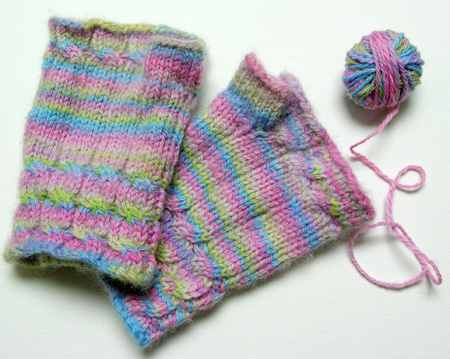 |
| Fetching mitts
knit from Navajo-plied merino hand-spun |
Once everyone in the
family is sporting a fabulous chunky hat, and
the bookcase is overflowing with skeins which
you put on display because they are “just too pretty to make anything out
of”, you may find yourself wondering what
else you can do with your hand-spun yarn.
There is a limit to the
number of scarves we and our families need,
so unless you wish to design from scratch every
hand-spun article you make, you will probably
be asking yourself whether you can substitute
hand-spun yarn in one of your favourite knitting
patterns. The answer is, of course, yes.
In
this article you will discover how to spin
a consistent yarn and achieve the gauge required
by the pattern you have in mind. We will also
look at the composition of some popular yarns
and discuss how to achieve a successful match.
You may even find some ideas for using up some
of those “too-pretty” skeins
to make room for the next exciting batch!

Not every commercial yarn can be replicated
exactly. Factories have spinning and plying processes
available to them which can hardly be achieved
on a domestic wheel, however, with a bit of ingenuity
you can come up with something that has a similar
gauge, composition and hand to the original yarn.
Gauge,
naturally, is most important. You cannot begin
to think about replacing a recommended yarn
if you don’t match the gauge -– just
as you wouldn’t substitute a mis-matched
commercial yarn. Don’t be discouraged,
though; it is not as difficult as you might think
to spin to a specified gauge: Just follow these
steps:
- Decide whether your yarn will be singles,
2-ply or 3-ply. This will depend on the yarn
you are trying to match, and the effect you
wish to achieve.
- Refer to the gauge table to see how thick
your singles should be spun.
- Spin a test length and measure the wraps
per inch (wpi) both in the single and after
plying. Even if the wpi is correct, knit a
swatch as well for extra reassurance.
- Keep your sample of singles handy while you
spin so you can regularly check for consistency.
Remember:
- Always measure a whole inch – do not
be tempted to stop at a quarter or a half and
multiply. Every wrap counts!
- The amount of twist in your yarn will affect
the gauge and wpi so make sure you spin your
sample as you plan to spin the whole skein and
make notes of wheel ratio and tension.
- In fact, keep notes on everything you do! You
will thank yourself when you want to replicate
your hand-spun later.
Weight |
Laceweight |
Fingering |
Double
Knit |
Worsted |
Gauge |
variable |
28sts
= 4in |
22sts
= 4in |
18sts
= 4in |
wpi – for
singles |
22 |
16 |
13 |
10 |
wpi – for
2-ply |
44 |
32 |
26 |
20 |
wpi – for
3-ply |
55 |
40 |
32 |
24 |
Composition can
be anything from easy to impossible, to match.
Many of the yarns we knit with are made of wool,
much of the fiber we spin is wool -– simple!
Fancy yarns and acrylic blends, however, may
require a bit more imagination to create something
similar. Don’t be afraid
to experiment and ‘fudge’ your fibers
a bit to achieve a similar yarn. With experience
you will find there are many ways around a tricky
composition -– and you may even like your
version better.
Hand is
the ‘feel’ of
the yarn and finished fabric. A tightly spun
cotton yarn feels completely different to a soft
singles of the same thickness. The number of
plies, the amount of twist in the yarn and the
finishing process will all affect the way your
knitted fabric feels and drapes. Once again,
experimenting with small amounts is the best
way to find hand that you like, and you’ll
soon find you get a ‘feel’ for creating
a certain type of yarn.

I
chose three popular wool blend yarns
to experiment with, opting for varying gauges,
compositions and purposes. The first is a worsted-weight,
softly textured yarn, popular for warm wintry
garments. Second, a favourite lace-weight yarn
which combines mohair fuzziness with the shimmer
of silk. Finally, a standard double knit yarn,
just the kind of thing you might choose for a
fall cardigan or a soft baby sweater.
Worsted Weight
It is apparent at first glance that this is
a singles spun yarn, and it is quite soft and
slightly fuzzy. The ball band states only that
it is 100% wool, but from the soft feel and what
I know of its felting properties, I am almost
certain it is merino, easy to find in my stash.
Gauge is straightforward, simply a matter of
keeping a small strand of the yarn close by while
spinning to make sure I match the thickness.
What I felt was important with this yarn was
to achieve the same thick softness and fuzziness
of the original. This called for a low-twist,
woollen-spun singles. I set my wheel on the lowest
ratio to minimise twist and pulled off short
lengths of merino roving, fluffing them out slightly
before spinning them from the fold.
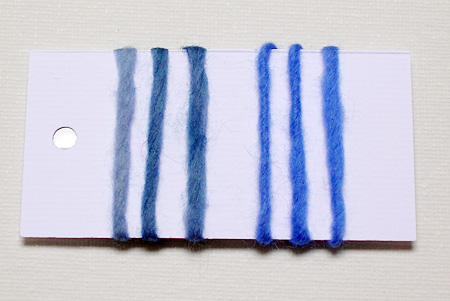
Commercial
worsted yarn (left) and hand-spun (right)
To help the yarn stay together and tame the
twistiness of the singles, I treated it to a
shock-and-whack treatment after winding off my
skein. This involved plunging the skein alternately
into hot and cold water and then whacking it
against the kitchen cupboards! In a soft singles
this felts the fibres slightly, helping to reduce
wear later and bringing out a fuzzy bloom on
the yarn.
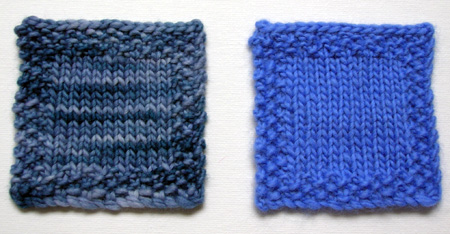
Swatches from
commercial worsted yarn (left) and hand-spun
(right)
After blocking, the appearance and hand of the
two swatches is almost identical. This is an
easy yarn to replicate and, being a singles,
allows great scope for playing with color and
texture in your planned garment.
Lace Weight
As
the lace-weight yarn knits up into a very open
fabric, I allowed myself a bit of leniency when
it came to composition and spinning. Firstly,
the commercial yarn is a blend of 67% mohair,
18% silk and 15% synthetic. That’s a lot
of mohair! What I might have done is spin a very
fine single of pure mohair, then a very fine
single of pure silk and ply them with a commercial
nylon thread to hold it all together. This did
not appeal to me – mostly because pure
mohair and I don’t really get along.
I chose instead to blend 50% kid mohair with
50% merino/silk blend using hand cards. The resulting
fluff was far more manageable than pure kid,
with the small amount of wool being just enough
to reduce the slipperiness. I set the wheel ratio
to high for maximum twist and spun very slowly
and as finely as possible, keeping an eye on
the fibres so the longer mohair did not creep
away leaving a pile of wool behind.
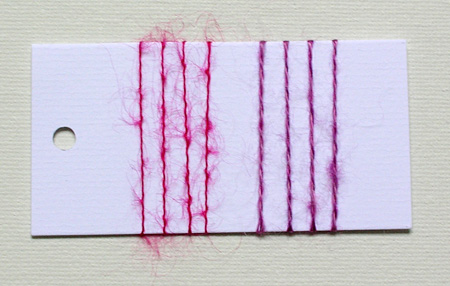
Commercial
lace-weight mohair yarn (left) and hand-spun
(right)
I plied the singles back on itself and then
treated it also to a good whacking to encourage
the mohair to bloom.
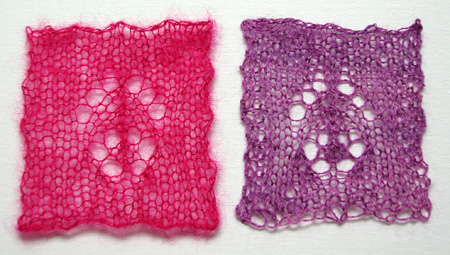
Swatches from
commercial lace-weight mohair yarn (left) and
hand-spun (right)
The hand-spun yarn is slightly
heavier and has a little less halo than the commercial
lace-weight (more halo than appears in the photo,
though). However, when knitted on the same needle
size and blocked, the swatches are not dissimilar.
Double Knit
This yarn is soft and bouncy with excellent
stitch definition and is my current favourite
for cable work. The crispness in the cables is
due to the almost perfect roundness of the yarn,
in this case, achieved through many very fine
singles being wrapped around a central core.
To replicate this as closely as possible, I chose
a superfine merino from my stash and spun a fine
singles for a 3-ply yarn.
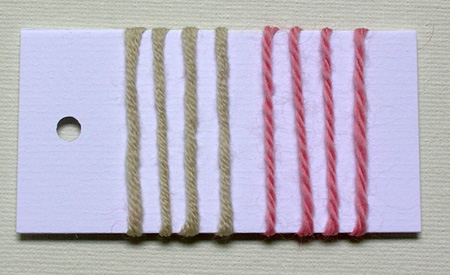
Commercial
DK yarn (left) and hand-spun (right)
The 3-ply has a nice roundness which closely
resembles the commercial sample. In the swatch,
it shows clear, crisp stitch definition.
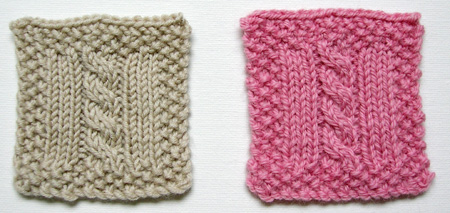
Swatches
from commercial DK yarn (left) and
hand-spun (right)
When dry, there is a slight difference to the
hand of the swatches: the commercial yarn is
a little softer. The handspun is still very soft,
however, and would feel great knit up as a sweater
or close-to-skin accessory.
Spinning your own yarn
for a pattern opens up a whole new world of
possibilities in color, texture and design.
You can plan exact color placement or spin
a little bit of textured yarn to use as a feature
in part of the garment. Don’t
be afraid of the time involved: in my experience,
it takes less time to spin two ounces of fiber
than it takes to knit up the same amount of a
similar yarn. And the satisfaction of having
created something completely from scratch will
stay with you forever!
|

